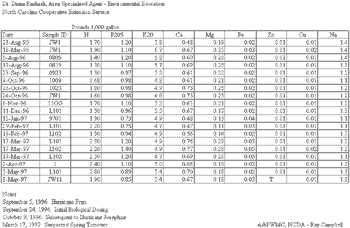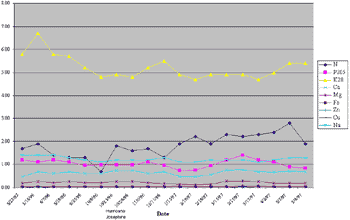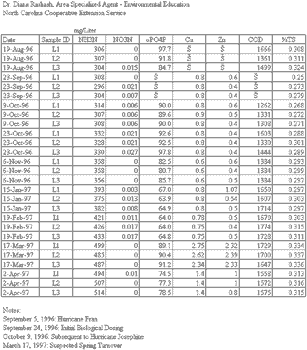
Draft
CSR Sludge Removal Project, Beulaville NC
Diana M.C. Rashash
Mike Williams
Abstract:
The lagoon for an 1800 hog feeder-to-finish operation was treated for seven months with a bacteria additive. Between September 23, 1996 and February 3, 1997, the mean sludge depth decreased from an average depth of 3.5 feet (range 2 to 5.5 feet) to an average depth of 2.1 feet (range 1 to 3 feet). The sludge depth decreased further to approximately 1.5 feet by March 17th and to 1.22 feet (range 0.75 to 1.5 feet) by May 5th. The concentrations of the micronutrients (copper and zinc) in the lagoon liquid remained fairly steady except for the spike that occurred in both the March 17, 1997 and March 18, 1996 samples. The concentration spikes may indicate seasonal turnover within the lagoon. The phosphorus results indicate a somewhat decreasing concentration trend until the suspected lagoon turnover date, whereas the potassium concentrations showed a continued decreasing or possibly cyclic trend. The nitrogen concentrations did not indicate any trend until January. The results from the latest sample dates indicate that the nitrogen concentrations may be decreasing again now that the weather is warming and the lagoon is restratifying. Ammonia concentrations in the lagoon liquid increased during the project, but the in crease may be seasonally related.
Background:
The test lagoon, which is located in North Carolina, is approximately 12 years old and had never previously had sludge removed. The lagoon was designed to have 243,000 ft3 of permanent storage. Overall lagoon dimensions were designed at 270 ft. x 200 ft. x 7 ft. Preliminary sludge depth measurements indicated that the lagoon contained 189,000 ft3 (1,413,720 gal) of sludge, which was greater than 50% of the permanent storage capacity. At current prices of $0.015/gal, conventional pumping of the sludge would have cost the farmer more than $21,200.00, not including any lagoon liquid that was removed along with the sludge.
A bacteria product (Biospan Organic Cleaner), which has been successfully used for sludge reduction at several industrial and municipal facilities, was used to treat the lagoon sludge.
Objectives:
The objectives of this project were:
- to evaluate the ability of the bacteria product to reduce the lagoon sludge content
- to evaluate the effect of the bacteria product on lagoon and swine house odors, and
- to observe the effect of the bacteria product on nutrient concentrations in the lagoon liquid.
Procedures:
Dosing schedule: Beginning in September 1996, the lagoon for an 1800 hog feeder-to-finish operation was dosed with Biospan Organic Cleaner according to the following schedule:
Purging doses (5 applicators x 4 lbs. per applicator, plus 1/2 lb. in each of the three left-hand recycle tanks): Sept. 24, Sept. 30, Oct 9, Oct 16, Oct 23, Oct 30, Nov. 6, Nov. 25, Dec. 11, Dec 17, Dec. 30, Jan 15, Feb. 3, Feb. 19, March 3, and March 17.
Maintenance doses (5 applicators x 2 lbs. per applicator): April 2, May 5, and scheduled once per month for the next three months.
Lagoon applicators: Five 4-inch PVC pipes were placed around the edge of the lagoon. The upper end of each tube was covered with a screw-on cap, which was removed for application of the bacteria product. Pre-measured amounts of the bacteria were poured down each tube, then the tubes were flushed with 1-gallon of lagoon liquid. The bacteria would go down the tubes and enter the lagoon through the last 3 feet of tubing, which was perforated.
Measurements: Lagoon liquid samples were collected and sent to the North Carolina State University Biological and Agricultural Engineering (BAE) laboratory, the North Carolina Department of Agriculture (NCDA) laboratory, and the Duke University olfactory laboratory. Cotton swatches, which had been left for one hour at specific locations around th e lagoon and within each swine house, were also sent to the Duke University olfactory laboratory. Ammonia concentrations within the swine houses were determined using Drager tubes.
Results and Discussion:
Sludge depths: As of May 5, the lagoon sludge volume had been reduced to 65,880 ft3 (a 65% reduction). Lagoon sludge depths in September, February, and May are presented in
Figures 1-3.
The test lagoon was constructed with a clay liner, which is an important consideration. Some older lagoons were left to seal themselves through the formation of an organic layer. The increased bacterial activity may remove the organic seal and increase the potential for nutrient movement into the groundwater. It was recommended to the bacteria product distributor that groundwater monitoring wells be installed if the product is used to treat unlined lagoons. The wells should be tested periodically for nitrate and ammonia,
Nutrients:
The concentrations of the micronutrients (copper and zinc) in the lagoon liquid remained fairly steady except for the spike that occurred in both the March 17, 1997 and March 18, 1996 samples. It is likely that the concentration spikes indicate seasonal turnover within the lagoon. The phosphorus results indicate a somewhat decreasing concentration trend until the suspected lagoon turnover date, whereas the potassium concentrations showed a continued decreasing or possibly cyclic trend. The nitrogen concentrations did not indicate any trend until January. The results from the latest sample dates indicate that the nitrogen concentrations may be decreasing again now that the weather is warming and the lagoon is restratifying. Ammonia concentrations in the lagoon liquid increased during the project, but the increase may be seasonally related.
Odors:
The swine facility did not have very much odor at the beginning of the project, so it was difficult to assess if there was any significant change. The facility was very well run and maintained. Of the odors that were detected during on-site visits, the lagoon odors were less intense than those from the swine houses.
Conclusions:
Some of the conclusions from this project are as follows:
- The added bacteria appear to be quite effective at sludge reduction. The product may be useful in both sludge level maintenance and lagoon closure situations.
- More information is required to make a decision on the use of the product for odor
control.
- Changes in nutrient concentrations in the liquid fraction during sludge reduction appear
to be minor for most of the nutrients of concern.
- Changes in nitrogen (lb/1,000 gal) can be monitored by the farmer through NCDA
analyses. Adjustments in land application amounts can then be made.
- No significant changes in the percentage of solids were observed in the lagoon liquid;
therefore, the treatment should not increase any adverse effects on irrigation
Contact Us
Phone: 541-388-4546
Email: drsenviro@gmail.com



